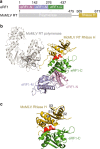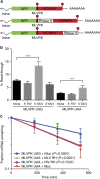Structural basis of suppression of host translation termination by Moloney Murine Leukemia Virus
- PMID: 27329342
- PMCID: PMC4917968
- DOI: 10.1038/ncomms12070
Structural basis of suppression of host translation termination by Moloney Murine Leukemia Virus
Abstract
Retroviral reverse transcriptase (RT) of Moloney murine leukemia virus (MoMLV) is expressed in the form of a large Gag-Pol precursor protein by suppression of translational termination in which the maximal efficiency of stop codon read-through depends on the interaction between MoMLV RT and peptidyl release factor 1 (eRF1). Here, we report the crystal structure of MoMLV RT in complex with eRF1. The MoMLV RT interacts with the C-terminal domain of eRF1 via its RNase H domain to sterically occlude the binding of peptidyl release factor 3 (eRF3) to eRF1. Promotion of read-through by MoMLV RNase H prevents nonsense-mediated mRNA decay (NMD) of mRNAs. Comparison of our structure with that of HIV RT explains why HIV RT cannot interact with eRF1. Our results provide a mechanistic view of how MoMLV manipulates the host translation termination machinery for the synthesis of its own proteins.
Figures






Similar articles
-
Reverse transcriptase of Moloney murine leukemia virus binds to eukaryotic release factor 1 to modulate suppression of translational termination.Cell. 2003 Oct 31;115(3):319-31. doi: 10.1016/s0092-8674(03)00805-5. Cell. 2003. PMID: 14636559
-
MoMLV reverse transcriptase regulates its own expression.Cell. 2003 Oct 31;115(3):250-1. doi: 10.1016/s0092-8674(03)00850-x. Cell. 2003. PMID: 14636552
-
Genetic reprogramming by retroviruses: enhanced suppression of translational termination.Cell Cycle. 2004 Feb;3(2):123-5. Cell Cycle. 2004. PMID: 14712070 Review.
-
Translational readthrough-promoting drugs enhance pseudoknot-mediated suppression of the stop codon at the Moloney murine leukemia virus gag–pol junction.J Gen Virol. 2015 Nov;96(11):3411-3421. doi: 10.1099/jgv.0.000284. J Gen Virol. 2015. PMID: 26382736 Free PMC article.
-
Murine leukemia virus reverse transcriptase: structural comparison with HIV-1 reverse transcriptase.Virus Res. 2008 Jun;134(1-2):186-202. doi: 10.1016/j.virusres.2008.01.001. Epub 2008 Feb 21. Virus Res. 2008. PMID: 18294720 Free PMC article. Review.
Cited by
-
M-MuLV reverse transcriptase: Selected properties and improved mutants.Comput Struct Biotechnol J. 2021 Nov 22;19:6315-6327. doi: 10.1016/j.csbj.2021.11.030. eCollection 2021. Comput Struct Biotechnol J. 2021. PMID: 34900141 Free PMC article. Review.
-
Translation Termination and Ribosome Recycling in Eukaryotes.Cold Spring Harb Perspect Biol. 2018 Oct 1;10(10):a032656. doi: 10.1101/cshperspect.a032656. Cold Spring Harb Perspect Biol. 2018. PMID: 29735640 Free PMC article. Review.
-
Enhancing thermostability of Moloney murine leukemia virus reverse transcriptase through greedy combination of multiple mutant residues.Bioresour Bioprocess. 2025 Feb 20;12(1):12. doi: 10.1186/s40643-025-00845-0. Bioresour Bioprocess. 2025. PMID: 39979673 Free PMC article.
-
A flexible split prime editor using truncated reverse transcriptase improves dual-AAV delivery in mouse liver.Mol Ther. 2022 Mar 2;30(3):1343-1351. doi: 10.1016/j.ymthe.2022.01.005. Epub 2022 Jan 5. Mol Ther. 2022. PMID: 34998953 Free PMC article.
-
Translational recoding signals: Expanding the synthetic biology toolbox.J Biol Chem. 2019 May 10;294(19):7537-7545. doi: 10.1074/jbc.REV119.006348. Epub 2019 Apr 1. J Biol Chem. 2019. PMID: 30936208 Free PMC article. Review.
References
Publication types
MeSH terms
Substances
Grants and funding
LinkOut - more resources
Full Text Sources
Other Literature Sources

